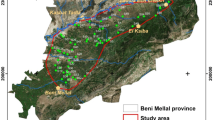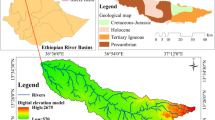Abstract
In this study, an innovative approach was carried out using the geographic information systems (GIS)-based multi-criteria evaluation model to assign the use priority in agricultural lands needing to be improved for management and sustainability of biochar application in the soil. The model included (1) site suitability assessments, (2) standardization of assessment factors, and (3) equal-weighted overlay. By this model, the first map of primary biochar application areas for Turkey was prepared. As a result, the suitability scores were divided into five classes in the range of 0.20–0.90, and thus, the areas were found mostly in the moderate suitability (between 0.49 and 0.64). Consequently, it was determined that the biochar application was very highly suitable in the Aegean and Marmara regions. While the western and central parts of the Mediterranean region had high suitability, Central Anatolia and Southeastern Anatolia regions had very low suitability. The study results also indicated that the requirement for biochar addition was very low in the arable agricultural areas such as Harran in the Southeastern Anatolia region, Çukurova in the Mediterranean region, and Konya and Amasya in the Central Anatolia region. However, there is a need for showing particular attention to the agricultural areas of the Aegean Region, Ergene in the Marmara Region, and Iğdır in the Eastern Anatolian region due to higher biochar need for intensive agriculture.
Graphic abstract

Similar content being viewed by others
References
Ahmed HP, Schoenau JJ (2015) Effects of biochar on yield, nutrient recovery, and soil properties in a canola (Brassica napus L.)-wheat (Triticum aestivum L.) rotation grown under controlled environmental conditions. Bioenergy Res 8:1183–1196
Ajiboye GA, Hammed SG, Bada SB, Adesodun JK, Dare MO, Mesele SA (2019) Changes in the morphogenetic and physicochemical properties of an alfisol as affected by the healing period after charcoal production. Commun Soil Sci Plan 50:321–332. https://doi.org/10.1080/00103624.2018.1563099
Aksoy E, Panagos P, Montanarella L, Jones A (2010) Integration of the soil database of turkey into European soil database 1:1.000.000. JRC scientific and technical research report, Italy, p 54
Alkharabsheh HM, Seleiman MF, Battaglia ML, Shami A, Jalal RS, Alhammad BA, Almutairi KF, Al-Saif AM (2021) Biochar and its broad impacts in soil quality and fertility, nutrient leaching and crop productivity: a review. Agronomy 11:993. https://doi.org/10.3390/agronomy11050993
Anyanwu IN, Alo MN, Onyekwere AM, Crosse JD, Nworie O, Chamba EB (2018) Influence of biochar aged in acidic soil on ecosystem engineers and two tropical agricultural plants. Ecotoxicol Environ Saf 153:116–126. https://doi.org/10.1016/j.ecoenv.2018.02.005
Aydin F, Sarptas H (2020) Spatial assessment of site suitability for solar desalination plants: a case study of the coastal regions of Turkey. Clean Techn Environ Policy 22:309–323. https://doi.org/10.1007/s10098-019-01783-0
BEPA (2016) Ministry of energy and natural resources: Turkish biomass energy potential map http://bepa.yegm.gov.tr/ (in Turkish). Accessed 10 May 2017
BİLGEM (2018) Toprak Organik Karbonu Projesi Teknik Raporu (Technical Report of Soil Organic Carbon Project), Project No: 100311 (in Turkish)
Bilgili et al (2019) The effects of biochars produced from the residues of locally grown crops on soil quality variables and indexes. Geoderma 345:123–133. https://doi.org/10.1016/j.geoderma.2019.03.010
Bruun EW, Petersen CT, Hansen E, Holm JK, Hauggaard-Nielsen H (2014) Biochar amendment to coarse sandy subsoil improves root growth and increases water retention. Soil Use Manag 30:109–118
Cangir C, Kapur S, Boyraz D, Akca E, Eswaran H (2000) An assessment of land resource consumption in relation to land degradation in Turkey. J Soil Water Conserv 55:253–259
CEM (2018) Soil organic carbon project, technical report in Turkish, Ankara, Turkey, p 36
Chathurika JAS, Kumaragamage D, Zvomuya F, Akinremi OO, Flaten DN, Indraratne SP, Dandeniya WS (2016) Woodchip biochar with or without synthetic fertilizers affects soil properties and available phosphorus in two alkaline, chernozemic soils. Can J Soil Sci 96:472–484
Cong WW, Meng J, Ying SC (2018) Impact of soil properties on the soil methane flux response to biochar addition: a meta-analysis. Environ Sci Proc Impacts 20:1202–1209. https://doi.org/10.1039/C8EM00278A
CORINE Land Cover data (2012) https://www.eea.europa.eu/publications/COR0-landcover. Accessed 10 Nov 2018
Du ZJ, **ao YT, Qi XB, Liu YA, Fan XY, Li ZY (2018) Peanut-shell biochar and biogas slurry improve soil properties in the North China plain: a four-year field study. Sci Rep 8:9
El-Naggar A, Lee SS, Rinklebe J, Farooq M, Song H, Sarmah AK, Zimmerman AR, Ahmad M, Shaheen SM, Ok YS (2019) Biochar application to low fertility soils: a review of current status, and future prospects. Geoderma 337:536–554
Environmental Systems Research Institute (ESRI) (1969). Accessed 06 Oct 2018
Food and Agriculture Organization of the United Nations (FAO) (2015) Soils help to combat and adapt to climate change by playing a key role in the carbon cycle. Accessed 20 Mar 2019
Gunal E, Erdem H, Celik I (2018) Effects of three different biochars amendment on water retention of silty loam and loamy soils. Agric Water Manag 208:232–244. https://doi.org/10.1016/j.agwat.2018.06.004
Hall GB, Wang F, Subaryono (1992) Comparison of Boolean and fuzzy classification methods in land suitability analysis by using geographical information systems. Environ Plan A 24:497–516. https://doi.org/10.1068/a240497
He M, **ong X, Wang L, Hou D, Bolan NS, Ok YS, Rinklebe J, Tsang DCW (2021) A critical review on performance indicators for evaluating soil biota and soil health of biochar-amended soils. J Hazard Mater 414:125378. https://doi.org/10.1016/j.jhazmat.2021.125378
Hengl T, Mendes de Jesus J, Heuvelink GBM, Gonzalez MR, Kilibarda M, Blagotić A, Shangguan W, Wright MN, Geng X, Bauer-Marschallinger B, Guevara MA, Vargas R, MacMillan RA (2017) SoilGrids250m: global gridded soil information based on machine learning. PLoS ONE. https://doi.org/10.1371/journal.pone.0169748
Hobley E, Wilson B, Wilkie A, Gray J, Koen T (2015) Drivers of soil organic carbon storage and vertical distribution in Eastern Australia. Plant Soil 390:111–127. https://doi.org/10.1007/s11104-015-2380-1
Jankowski P (1995) Integrating geographical information systems and multiple criteria decision making methods. Int J Geogr Inf Syst 9:251–273. https://doi.org/10.1080/02693799508902036
Jeffery S, Verheijen FGA, van der Velde M, Bastos AC (2011) A quantitative review of the effects of biochar application to soils on crop productivity using meta-analysis. Agr Ecosyst Environ 144:175–187. https://doi.org/10.1016/j.agee.2011.08.015
Jiang H, Eastman JR (2000) Application of fuzzy measures in multi-criteria evaluation in GIS. Int J Geogr Inf Sci 14:173–184. https://doi.org/10.1080/136588100240903
Kao C (2010) Fuzzy data standardization. IEEE Trans Fuzzy Syst 18:745–754. https://doi.org/10.1109/TFUZZ.2010.2047948
Kapur S, Akca E, Kapur B, Ozturk A (2006) Migration: an irreversible impact of land degradation in Turkey. In: Kepner WG, Rubio JL, Mouat DA, Pedrazzini F (eds) Desertification in the Mediterranean region. A security issue. Springer, Dordrecht
Kapur S, Akca E, Gunal H (2018) The soils of Turkey. Springer, Cham
Krapfl KJ, Hatten JA, Roberts SD, Baldwin BS, Rousseau RJ, Shankle MW (2014) Soil properties, nitrogen status, and switchgrass productivity in a biochar-amended silty clay loam. Soil Sci Soc Am J 78:S136–S145
Kutlu O, Kocar G (2017) Biochar from residual biomass in Turkey, and possibility of return to the soil: an estimation of the supply and demand. Pol J Agron 30:10–24
Clark Labs (1987). Product: Terrset. Accessed 06 Nov 2018
Lal R (2016) Biochar and soil carbon sequestration. In: Guo M, He G, Uchimiya SM (eds) Agricultural and environmental applications of biochar: advances and barriers. Soil Science Society of America, Madison, pp 175–197
Latawiec AE, Peake L, Baxter H, Cornelissen G, Grotkiewicz K, Hale S, Krolczyk JB, Kubon M, Lopatka A, Medynska-Juraszek A, Reid BJ, Siebielec G, Sohi SP, Spiak Z, Strassburg BBN (2017) A reconnaissance-scale GIS-based multicriteria decision analysis to support sustainable biochar use: Poland as a case study. J Environ Eng Landsc 25:208–222. https://doi.org/10.3846/16486897.2017.1326924
Lehmann J, Joseph ST (2009) Biochar for environmental management: an introduction. In: Lehmann J, Joseph ST (eds) Biochar for environmental management: science and technology, 1st edn. Earthscan, London, pp 1–12
Lentz RD, Ippolito JA (2012) Biochar and manure affect calcareous soil and corn silage nutrient concentrations and uptake. J Environ Qual 41:1033–1043. https://doi.org/10.2134/jeq2011.0126
Liang B, Lehmann J, Solomon D, Kinyangi J, Grossman J, O’Neill B, Skjemstad JO, Thies J, Luizao FJ, Petersen J, Neves EG (2006) Black carbon increases cation exchange capacity in soils. Soil Sci Soc Am J 70:1719–1730. https://doi.org/10.2136/sssaj2005.0383
Liu XY, Zhang AF, Ji CY, Joseph S, Bian RJ, Li LQ, Pan GX, Paz-Ferreiro J (2013) Biochar’s effect on crop productivity and the dependence on experimental conditions-a meta-analysis of literature data. Plant Soil 373:583–594. https://doi.org/10.1007/s11104-013-1806-x
Liu CH, Chu WY, Li H, Boyd SA, Teppen BJ, Mao JD, Lehmann J, Zhang W (2019) Quantification and characterization of dissolved organic carbon from biochars. Geoderma 335:161–169. https://doi.org/10.1016/j.geoderma.2018.08.019
Macdonald LM, Farrell M, Van Zwieten L, Krull ES (2014) Plant growth responses to biochar addition: an Australian soils perspective. Biol Fertil Soils 50:1035–1045. https://doi.org/10.1007/s00374-014-0921-z
Malczewski J, Rinner C (2015) Multicriteria decision analysis in geographic information science. Advances in geographic information science. Springer, New York
Namli A, Akça MO, Akça H (2017) Tarımsal atıklardan elde edilen biyokömürün buğday bitkisinin gelişimi ve bazı toprak özellikleri üzerine etkileri. Toprak Bilimi Ve Bitki Besleme Dergisi 5(1):39–47 (in Turkish)
Ozbahce A, Sonmez B, Akgul S, Kececi M (2018) Establishment of geographical database of the productivity and the soil organic carbon content for Turkey's soils (in Turkish). In: TAGEM/TSKAD/11/A13/P03, P.r. (Ed.), p 97
Ozdemir S, Nuhoglu NN, Dede OH, Yetilmezsoy K (2018) Mitigation of soil loss from turfgrass cultivation by utilizing poultry abattoir sludge compost and biochar on low-organic matter soil. Environ Technol. https://doi.org/10.1080/09593330.2018.1502363
Pandit NR, Mulder J, Hale SE, Zimmerman AR, Pandit BH, Cornelissen G (2018) Multi-year double crop** biochar field trials in Nepal: finding the optimal biochar dose through agronomic trials and cost-benefit analysis. Sci Total Environ 637:1333–1341. https://doi.org/10.1016/j.scitotenv.2018.05.107
Qin P, Wang HL, Yang X, He LZ, Muller K, Shaheen SM, Xu S, Rinklebe J, Tsang DCW, Ok YS, Bolan N, Song ZL, Che L, Xu XY (2018) Bamboo- and pig-derived biochars reduce leaching losses of dibutyl phthalate, cadmium, and lead from co-contaminated soils. Chemosphere 198:450–459. https://doi.org/10.1016/j.chemosphere.2018.01.162
Rahman MT, Zhu QH, Zhang ZB, Zhou H, Peng X (2017) The roles of organic amendments and microbial community in the improvement of soil structure of a vertisol. Appl Soil Ecol 111:84–93. https://doi.org/10.1016/j.apsoil.2016.11.018
Senbayram M, Saygan EP, Chen R, Aydemir S, Kaya C, Wu D, Bladogatskaya E (2019) Effect of biochar origin and soil type on the greenhouse gas emission and the bacterial community structure in N fertilised acidic sandy and alkaline clay soil. Sci Total Environ 660:69–79. https://doi.org/10.1016/j.scitotenv.2018.12.300
Soilgrids (2019) https://soilgrids.org/. Accessed 08 July 2021
Sonmez B, Ozbahce A, Kececi M, Akgul S, Aksoy E, Madenoglu S, Karabulut-Aloe A, Incirkus V, Gorgisen C, Tuncay T, Beernearts I, Vergas R (2017) Turkey's national geospatial soil organic carbon information system. In: Global symposium on soil organic carbon, Rome, Italy
Uyan M (2017) Optimal site selection for solar power plants using multi-criteria evaluation: a case study from the Ayranci region in Karaman, Turkey. Clean Techn Environ Policy 19:2231–2244. https://doi.org/10.1007/s10098-017-1405-2
Vaccari FP, Baronti S, Lugato E, Genesio L, Castaldi S, Fornasier F, Miglietta F (2011) Biochar as a strategy to sequester carbon and increase yield in durum wheat. Eur J Agron 34:231–238
Zadeh LA (1965) Fuzzy sets. Inf Control 8:338–353
Author information
Authors and Affiliations
Contributions
All authors contributed to the study conception and design. Outline of the manuscript and methodology were designed by FA-K and OK. Data collection and GIS-MCE analysis were performed by FA-Kr. Results were evaluated by OK and FA-K. The first draft of the manuscript was written by FA-K, OK and HS, and all authors commented on previous versions of the manuscript. All authors read and approved the final manuscript.
Corresponding author
Additional information
Publisher's Note
Springer Nature remains neutral with regard to jurisdictional claims in published maps and institutional affiliations.
Rights and permissions
About this article
Cite this article
Kutlu, O., Aydin-Kandemir, F. & Sarptas, H. Assessing primary areas for a sustainable biochar application in soil by using GIS-based multi-criteria evaluation. Clean Techn Environ Policy 23, 2443–2455 (2021). https://doi.org/10.1007/s10098-021-02163-3
Received:
Accepted:
Published:
Issue Date:
DOI: https://doi.org/10.1007/s10098-021-02163-3












